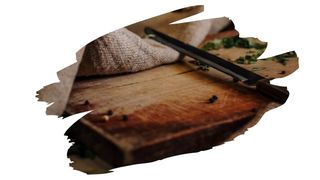Do you want a cutting board oil that’ll not only make your chopping board gift look incredible — but will also help protect it?
Applying a natural penetrating oil, or a natural hard wax, are two cutting board finishes that will achieve exactly that. So, why not use both of them combined?
Well, in both Walrus Oil and Odie’s Oil, you have two food-safe oil/wax blend products that work great on cutting boards.
But, what really sets these two finishes apart?
Walrus oil cutting board oil is a non-drying penetrating oil made from all natural ingredients. This semi-gloss wood finish will stop rancid liquids from ruining your beautiful cutting board.
Odie’s oil, on the other hand, is a hard wax penetrating oil finish that’ll dry into a high gloss water resistant coat.
Both of these products are very easy to apply, and dry so quickly (in under 24 hours) you could be using your chopping block within the day.
Still, despite making your cutting board look amazing, oils and waxes are famous for being short term finishes. Daily use, (and the regular washing of cutting boards), means that any product you apply onto a chopping board is going to wear off sooner rather than later.
And why should you opt for either one of these finishes over simply using an inexpensive food-grade mineral oil treatment?
Well, in this post, you will learn what really separates non-drying oil finishes from hard wax. And why a combination of both work so well.
You’ll also discover what the best oil is for your cutting board (Quick Hint: Most food safe non-drying oils are a no-go).

This post may contain affiliate links to products that we receive a commission for (at no additional cost to you). Learn more here.
How Do You Seal A Homemade Cutting Board?
The best way to seal a cutting board is by applying a food grade non-drying oil or some other non-toxic sealer to it.
A non-drying oil won’t last on that board forever though, so you will need to reapply it at least once every 2 to 4 weeks.
What’s The Best Oil For Cutting Boards?
By far, the best oil for a cutting board or butcher block is Mineral Oil. Specifically, it needs to be food grade 100% petroleum distillate mineral oil.
This oil is naturally sourced, is non-toxic, and it won’t go rancid.
Can You Use Vegetable Oil To Seal A Cutting Board?
You should avoid using any food-sourced oils, like vegetable oil, on your cutting board.
You see, vegetable oil will go rancid. As will any raw food-based oil such as olive oil or nut-based oils.
Can You Wax A Cutting Board?
Absolutely! In fact waxing a cutting board is a great alternative way to seal a cutting board without having to soak it in mineral oil.
What Wax Goes Best On A Cutting Boards?
Use beeswax on that chopping block, as this particular type of wax is both water-resistant and food-safe to boot. Which means it can be safely used on cutting boards, butcher blocks, and even on wooden spoons.
Related Post: 5 Easy Halloween Wooden Spoons (Make ‘Em In Under 30 Minutes!)
Is Oil Or Wax Better For Cutting Boards?
A penetrating oil protects wood from the inside out, sinking below the surface to cover every fiber.
Wood wax, however, takes a slightly different approach. It will coat the surface of wood, rubbing out into a brilliant shine. However, it is when you combine the two together that you truly get a next-level wood finish.
And this is where specialized cutting board oil products, (such as Walrus oil and Odie’s oil), come in…

Walrus Oil
What Is Walrus Oil Made Of? And What Does Walrus Oil Do To Wood?
Walrus Cutting Board Oil is made from a blend of eco-friendly non-toxic ingredients. The four key ingredients in Walrus oil are; mineral oil, coconut oil, beeswax and vitamin E.
This stuff will soak right into wood, just like pure mineral oil does. And after you give it a chance to dry, (around 12 to 24 hours), it will enhance the appearance of wood and make it more water repellent.
Is Walrus Oil A Drying Oil?
No, it is not. Walrus is a non-drying oil, meaning that it will not cure and harden.
A drying oil would be something like Linseed oil or Tung oil. These drying oils will dry and cure into a scratch-resistant coat.
Related Post: Can You Put Tung Oil On Maple Wood (For An Effortless Finish)?
Will Walrus Oil Go Rancid?
Thankfully, Walrus oil will not go off. Since this products main ingredient, (mineral oil), is naturally sourced from petroleum, it will not go rancid at all.
Walrus Oil Pros
1). It uses all natural ingredients, (and it contains absolutely zero actual ‘walrus’ blubber!).
2). It makes wood more water-resistant than just mineral oil alone, (thanks to it’s beeswax ingredient).
3). And it is incredibly affordable, (selling at less than a third of the price of other cutting board oil alternatives).
Walrus Oil Cons
1). It will need to be reapplied more frequently than Odie’s oil.
2). It will prevent water damage, but it is not scratch resistant.
You can check out the latest prices for Walrus Cutting Board Oil over here on Amazon.

Odie’s Oil
Can You Really Use Odie’s Oil On A Cutting Board?
Yes you can, because Odie’s oil is solvent-free and food-safe.
Made by blending different natural oils and wax, this hard wax finish doesn’t need much elbow grease to get it to layer smoothly onto your cutting board either.
Does Odie’s Oil Darken Wood?
If you have purchased Odie’s Dark product, then it will. Odie’s Dark will darken wood further over time too.
But the clear original Odie’s oil product will not darken wood much at all. At least not beyond the standard deeper hue you’d expect from applying any sort of oil on a wooden surface.
Also, fun fact, you can tint Odie’s clear oil to your own personal color choice. That is because Odie’s sell pigments, (under the Mr. Cornwalls’ Creative Color range), that’ll blend right into their hard wax oil.
Doing this will allow you to ‘stain’ the wood of the cutting board to your liking.
Quick Note: Odie’s oil pigments are made from finely ground oxidized 100% mineral pigments. Yet, while these naturally occurring minerals pigment additives are safe, they aren’t always necessarily food safe. So bear this in mind before you decide to add tinted-oil finishes to your cutting board.
The entire Odies oil Mr. Cornwalls’ Creative Color range can be found by clicking here.
Just How Durable Is Odie’s Oil?
It doesn’t harden like Danish oil or lacquer, but it is still fairly scratch-resistant all the same. But, Odie’s real durability boils down to the fact that any scratches in this wax finish are really easy to fix.
Related Post: Rubio Monocoat Vs Danish Oil For Your Kitchen Table
Odie’s Oil Pros
1). This stuff goes an incredibly long way. A jar of Odie’s oil can coat up to 250 square feet of wooden surface.
2). You can buy a wide range of pigments to tint the oil to the exact color you want.
3). Odie’s oil is easy to repair. And its waxy end product means that scratches aren’t clearly visible on it.
Odie’s Oil Cons
1). It is very expensive, especially compared to simply making your own homemade mineral oil/beeswax recipe.
2). You will need to wait a lengthy 3-5 days for Odie’s oil to cure, before you can start to use your cutting board.
You can find the latest prices for Odie’s Oil over on Amazon.
To Sum Up, Here Are The 3 Key Takeaways…
- Food safe non-drying oils go great on cutting boards. And beeswax works amazingly well at sealing wood grain. However, a combination of both works best.
- Walrus oil is much, much cheaper than Odie’s oil.
- However, a little Odie’s hard wax oil can go a lot further than Walrus oil.



